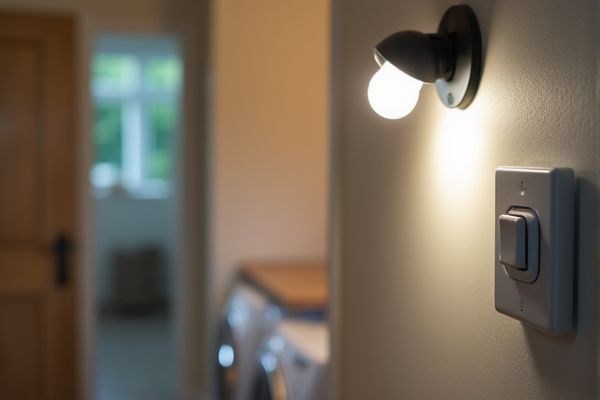
Motion sensor lights in laundry rooms save energy by automatically turning on when you enter and off when you leave, reducing waste and enhancing convenience. Explore the rest of the article to discover which lighting option best suits your laundry needs.
Table of Comparison
| Feature | Motion Sensor Light | Manual Switch Light |
|---|---|---|
| Operation | Automatically turns on/off based on movement detection | Requires manual on/off switching |
| Energy Efficiency | High - reduces energy waste by activating only when needed | Moderate - risk of leaving lights on unnecessarily |
| Convenience | Hands-free operation, ideal for laundry tasks | Requires physical interaction, less convenient when hands are full |
| Installation | Requires motion sensor wiring or battery-powered units | Simple installation, standard light switch setup |
| Cost | Higher upfront cost due to sensor technology | Lower initial cost, basic switch only |
| Maintenance | Sensor calibration and potential battery replacement | Low maintenance, rarely requires servicing |
| Suitability for Laundry | Excellent for hands-free lighting in laundry rooms | Functional but less ideal when handling wet or heavy laundry |
Introduction: Choosing the Right Lighting for Your Laundry Room
Motion sensor lights in laundry rooms enhance convenience by automatically illuminating the space when you enter, reducing energy waste and improving safety. Manual switch lights give you complete control over lighting, allowing you to adjust brightness and timing according to your needs. Choosing the right lighting depends on your preferences for energy efficiency, ease of use, and the specific layout of your laundry area.
Overview: Motion Sensor Light vs Manual Switch Light
Motion sensor lights for laundry areas automatically detect movement, enhancing energy efficiency and convenience by illuminating the space only when needed. Manual switch lights require user activation, offering straightforward control but potentially wasting energy if left on unintentionally. Choosing between motion sensor and manual switch lighting depends on factors like usage frequency, energy savings goals, and user preference for automation.
Energy Efficiency: Which Option Saves More Power?
Motion sensor lights in laundry rooms save more power by automatically turning off when no movement is detected, reducing unnecessary energy consumption. Manual switch lights depend entirely on user habits, often leading to lights being left on longer than needed. Using a motion sensor light ensures your laundry area is lit only when in use, maximizing energy efficiency and lowering utility bills.
Convenience & Accessibility: Hands-Free vs Traditional Control
Motion sensor lights in laundry rooms offer hands-free convenience, automatically illuminating the space when you enter, which enhances accessibility when your hands are full with laundry tasks. Manual switch lights require physical interaction to turn on or off, potentially slowing down your workflow and creating frustration in dim or cluttered areas. Choosing motion sensor lighting improves ease of use by providing seamless, touchless control, making your laundry routine more efficient and user-friendly.
Installation Process: Comparing Complexity and Cost
Motion sensor lights require more complex installation involving wiring to sensors and often a power source, increasing both labor time and initial cost compared to manual switch lights. Manual switch lights have a straightforward setup with simple wiring to a switch, lowering installation complexity and expenses. Homeowners typically incur higher upfront costs with motion sensor systems but benefit from energy savings over time.
Maintenance Requirements: Longevity and Upkeep
Motion sensor lights in laundry rooms offer reduced maintenance since their automatic operation minimizes wear on switches and bulbs, often featuring LED technology for extended longevity. Manual switch lights require frequent physical interaction, increasing the likelihood of switch wear and higher bulb replacement frequency due to longer usage times. Investing in motion sensor lights improves overall upkeep by reducing replacement costs and enhancing energy efficiency.
Safety & Security Benefits in Laundry Spaces
Motion sensor lights in laundry rooms enhance safety by automatically illuminating the space, reducing the risk of accidents such as slips and trips in dark or cluttered areas. These lights also improve security by deterring unauthorized access or intruders, as sudden light activation signals occupancy. Unlike manual switch lights, motion sensors provide hands-free operation, allowing users to avoid fumbling for switches when carrying laundry or handling wet clothes.
Cost Analysis: Upfront and Long-Term Expenses
Motion sensor lights for laundry rooms typically have higher upfront costs due to advanced sensors and installation requirements but can reduce long-term energy expenses by automatically turning off when not in use. Manual switch lights have lower initial costs and simple installation but may lead to higher electricity bills if lights are frequently left on unintentionally. Your choice depends on balancing upfront investment with potential energy savings over time.
User Experience: Everyday Use and Practicality
Motion sensor lights in laundry rooms enhance user experience by automatically illuminating the space when movement is detected, eliminating the need to find and flip a switch with dirty or wet hands. This hands-free convenience increases practicality, especially during busy or multitasking moments, improving safety by reducing the risk of slipping in dim light. Manual switch lights offer straightforward control and reliability, but require intentional operation, which may be less efficient during frequent in-and-out laundry activities.
Final Verdict: Best Lighting Choice for Your Laundry Room
Motion sensor lights in laundry rooms offer convenience and energy savings by automatically illuminating the space when you enter and turning off when not in use. Manual switch lights give you full control over lighting duration and brightness but may lead to unnecessary energy consumption if forgotten. Your best choice depends on your lifestyle; for efficiency and hands-free operation, motion sensors are ideal, while manual switches suit those who prefer direct control.
 homyna.com
homyna.com